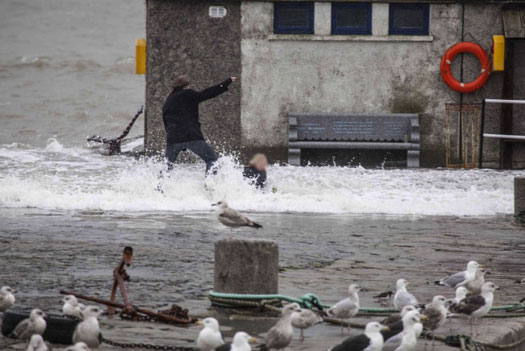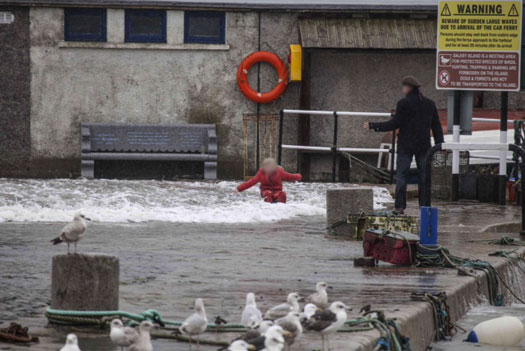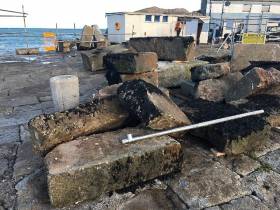Displaying items by tag: Bullock Harbour
Heritage Harbours Must Not be Forgotten in Plan to Rejuvenate Coastal Infrastructure - Senator Barry Ward
A Fine Gael Senator has raised the importance of funding for heritage harbours as part of the plan to support and rejuvenate coastal communities and infrastructure.
Speaking in the Seanad, Dún Laoghaire-based Senator Barry Ward welcomed the Government’s announcement of €35 million for local authority-owned piers and harbours, as part of the Brexit Infrastructure Fund.
However, he said that this must not be to the exclusion of heritage harbours and piers that may be less commercially viable.
“Many heritage harbours around the country are in dire need of investment to secure their futures and useability. This new €35 million fund, while very welcome, must not operate to the exclusion of heritage harbours, which play their own role in trade and as public amenities of historical importance. I hope that the Minister’s statement that this funding is an ‘unprecedented opportunity for us to invest in our publicly-owned piers and harbours’ includes all such piers and harbours.
"This is particularly true of ancient harbours like Bullock and Coliemore, whose role in early trade in this island is unparalleled, and which are now in significant stars of disrepair.
"Many heritage harbours around the country are in dire need of investment to secure their futures and useability"
Dun Laoghaire Harbour equally occupied a unique position in Irish history, both as a departure point for Irish emigrants and an arrival point for British monarchs and troops. Dún Laoghaire is a substantial Victorian engineering achievement that now badly needs repair and attention.
“Heritage harbours and piers may not be commercially viable, but they play a vital role in local communities as historical amenities and landmarks. I welcome the fact that the Minister’s task force noted the decline of many of these coastal structures, both in terms of their structural integrity and effective use, and I hope that local authorities will use this opportunity to apply for money to rejuvenate publicly-owned maritime heritage infrastructure throughout the country.”
Dun Laoghaire Harbour RNLI Rescue Two Missing Divers off Bullock in Fast Flowing Current
Last night Dun Laoghaire Harbour RNLI lifeboat station’s inshore lifeboat was requested to launch by the Irish Coast Guard to respond to reports of two missing divers near Bullock Harbour
The volunteer crew of three launched swiftly into the darkness at 11:06pm and made their way in the direction of Bullock Harbour arriving on scene at 11:15pm. The crew quickly assessed the situation and started to search the area around the outside of the harbour. The two casualties, who had been carrying out night diving training, were quickly located exhausted and trying to make their way back to shore having been caught by fast flowing currents.
The two divers were transferred on board and casualty care assessed by the volunteer crew. They confirmed that they were both very cold but in good health, they were taken ashore in Bullock Harbour aided by Dun Laoghaire Coast Guard Unit and then taken into the care of the National Ambulance Service.
Weather conditions at the time were described as calm with good search visibility.
Speaking following the call out, Nathan Burke Dun Laoghaire RNLI Helm said: ‘It has been Dun Laoghaire lifeboat stations busiest year to date, having been launched over 90 times with a dedicated crew turning up in numbers to every request. Tonight, was no different and our crew’s speedy response was a major factor in ensuring the outcome of this situation was a positive.’
‘The two divers and the other members of the group who were on shore did the right thing tonight by quickly contacting the Coast Guard when the two divers did not return to shore. The group also had the correct equipment for their training. Fortunately, both casualties are in good health. Our crew are very pleased with the outcome and happy to have safely returned them to shore’.
Bullock 200th Next Lecture: "Bullock Harbour into the Future - Monitoring And Repairs"
#lectures - As part of the Bullock Bicentenary, another lecture in the series about the small south Dublin Bay harbour is to be held next week in the Dalkey Castle and Heritage Centre.
Organiser of the lectures, Bullock Harbour Preservation Association (BHPA) in conjunction with the Dublin Port Company are continuing the talks on the history and heritage of Bullock given by excellent speakers from the Port Company and elsewhere.
The lectures will take place at 8pm each evening in Dalkey Castle & Heritage Centre and all are welcome and there is no longer any need to pre-book places.
The third lecture held so far last month, was presented by Elizabeth Shotton and according to the BHPA attracted the largest audience yet with almost 200 in attendance. Her presentation of the Lidar survey of the stonework with amazing 3D graphics overlaid on historic paintings and modern photos was outstanding.
Forthcoming next two lectures are:
Tuesday 12 February 8pm "Bullock Harbour into the Future - Monitoring and Repairs" presented by Eamon McElroy, Port Engineer, Dublin Port Company
This should be a very interesting talk in view of the current survey and repair work at the harbour by DPC as previously reported on Afloat.ie. For further updates on related developments click here.
Tuesday 12 March 8pm "The Port across the Bay - evolution from the early 19th century to 2040" **presented by Eamonn O'Reilly, Chief Executive Officer, Dublin Port Company **
** Please note the change of speaker and topic for the March lecture as Eamonn O'Reilly was unable to deliver BHPA's opening lecture in November, as Lar Joye spoke about the Port Archives in his place.
Bulloch Harbour's Bicencentary Talks Continue Against Backdrop of Storm Damaged Breakwater
#Bullock200 - The scenic south Dublin Bay harbour at Bulloch, Dalkey, is where construction on the stone-cut structure began in the winter 1818/19 and to celebrate the 200th anniversary a series of talks as Afloat previously highlighted will continue to May 2019.
The famous Dalkey landmark, used locally sourced granite to built the harbour for the Ballast Board (now managed by Dublin Port Company). The primary purpose of the harbour was to ship the granite from their quarry on Harbour Road to construct the city quays.
The present walls were built over the breakwater of the medieval fishing port in the tidal rocky creek at the foot of Bullock Castle. See previous coverage photo presenting the harbour in more sequal times! compared to the recent scene as depicted above.
Organisers of the monthly 'Bullock 200' lecture talks (p.17), the Bulloch Harbour Preservation Association (BHPA) and Dublin Port Company will be held in the Dalkey Castle & Heritage Centre.
Admission is free but places should be pre-booked through the Heritage Centre by emailing: [email protected]
Tuesday 4 December 8pm - The History and Heritage of Bullock Harbour
Rob Goodbody, Historic Building Consultant & Local Historian
Tuesday 22 January 8pm -The Building of Bullock Harbour
Elizabeth Shotton, Associate Professor, UCD School of Architecture, Planning & Environmental Policy
Tuesday 12 February 8pm - Bullock Harbour into the Future; Monitoring and Repairs
Eamon McElroy, Port Engineer, Dublin Port Company
Tuesday 12 March 8pm - Port Collections; History of the Port and the Port Archive
Lar Joye, Port Heritage Director, Dublin Port Company
Tuesday 9 April 8pm - Dublin Bay Biosphere
A Panel Discussion
Tuesday 9 May 2019 - Hugh Leonard Walk
with Danielle Keyes-Byrne
The talks are been supported by the Dalkey Community Council, Dalkey Tidy Towns and the Dalkey Castle & Heritage Centre.
As for the Dublin Port Company update on Bullock Harbour Storm Damage (Notice to Mariners No. 31) click here. As mentioned above in the photo-caption, repairs work to the harbour's main pier breakwater began last month and is due to be completed at the end of January 2019.
For much more on the history of the harbour and present day initiatives, among them the up-keep and maintenance of Bulloch (or spelt Bullock) Harbour, between the BHPA, DPC and DTT over the past couple of years click here.
Bullock Harbour, Dalkey Celebrates Bicentenary With Lecture Series
#Bullock200 - While taking a stroll at Bullock Harbour on Dublin Bay, a poster erected next to the former premises of Western Marine, highlights a lecture series celebrating the bicentenary of the landmark gem neighbouring Dalkey, writes Jehan Ashmore.
The scenic stone-cut charm of Bullock Harbour, this winter marks 200 years since construction began in 1818/19 by the Ballast Board (now Dublin Port Company) which still manages the small working harbour on the southern shores of Dublin Bay. The harbour is home to inshore fishing craft, the Dalkey Sea Scouts, a seasonal boat-hire fleet for anglers and is a popular spot for kayakers to embark from a slipway. In addition the attractive maritime setting draws an attentive audience of tourists.
Such present day use is in stark constrast to the origins behind the Ballast Board's reason in building the harbour. The principle purpose for its existance was to enable loading locally quarried granite rock to be shipped across Dublin Bay for constructing the capital quays.
The harbour's piers at Bullock were built over a previous breakwater of the medieval fishing village port, tucked in a tidal rocky creek at the foot of Bullock Castle. The Cistercian monks held lucrative fishing rights that came with the land though this had to be to protected from tribes in Wicklow.
The Castle remains intact and has commanding views overlooking the bay to Sandycove, Dun Laoghaire Harbour, the South Wall breakwater of Dublin Port and Howth Peninsula.
Bullock's Bicentenary Lecture Series
According to DPC's facebook, thanks was made to those who attended this week the first of six Bullock Harbour Bicentenary Lecture Series (to May 2019) held in the Dalkey Castle & Heritage Centre.
The inaugural lecture organised in partnership between Bullock Harbour Preservation Association (BHPA) and Dublin Port focused on the history, expansion and role of the port since 1707 and looking at the close links with the capital city.
The next lecture lined up in the Dalkey Castle & Heritage Centre will be held on:
Tuesday, 4 December at 8pm - The History and Heritage of Bullock Harbour
Speaker: Rob Goodbody, Historic Building Consultant & Local Historian
Further details of the remaining lectures will be posted shortly on Afloat.ie
Admission is free to attend the lectures but places should be pre-booked in advance with the DC&HC by emailing: [email protected]
The lectures have been supported by the Dalkey Community Council, Dalkey Tidy Towns and the Dalkey Castle & Heritage Centre
Search For Missing Man After Personal Watercraft Incident On Lower Lough Erne
#Missing - The PSNI and emergency services launched a major search operation yesterday afternoon (Sunday 9 September) when a man was reported missing after an incident with a personal watercraft on Lower Lough Erne.
According to RTÉ News, one man was rescued after swimming to the shore following the incident in Muckross Bay around 5.30pm.
An RNLI spokesperson said the search for the second individual is ongoing, and involves the PSNI boat and the Irish Coast Guard’s Rescue 118 helicopter from Sligo as well as fire and mountain rescue services.
Elsewhere, The Irish Times reports that a 12-year-old boy was rescued after falling on rocks at Bullock Harbour in Dalkey yesterday afternoon. The child, with a suspected ankle injury, was airlifted to hospital by the Dublin-based coastguard helicopter.
Risky Seaside Frolics Underline Dangers Of Stormy Weather
#WaterSafety - Photographer Aidan Tarbett sent us this and other shots of a man with two young children playing in the sea spray and high winds at Bullock Harbour in Dalkey, South Dublin on Monday 3 February.
In defiance of warnings to the public by the Irish Coast Guard to avoid exposed coastal areas as Ireland continues to be assaulted by storm-force winds and heavy sea swells, this man was very lucky not to see the children swept into the harbour by the waves crashing across the pier. Scroll down for more photos in the sequence.


An example of what can happen when such warnings are ignored occurred last month in Howth, when a man was swept by a wave off the upper section of the North Dublin port's East Pier, injuring his ankle in the 10-foot fall to the lower level.
And just three days ago 10 people had to be rescued from a bus struck by a large wave on the seafront in the Welsh town of Newgale.
































































